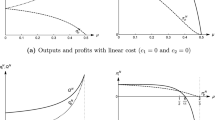Abstract
The paper considers tacit collusion in markets that are not fully transparent on both sides. Consumers only detect prices with some probability before deciding which firm to purchase from, and each firm only detects the other firm’s price with some probability. Increasing transparency on the producer side facilitates collusion, while increasing transparency on the consumer side makes collusion more difficult. Conditions are given under which increases in a common factor that affects transparency positively on both sides are pro-competitive. With two standard information technologies, this holds when firms are easier to inform than are consumers.
Similar content being viewed by others
Notes
It is straightforward to check that the second-order condition for a maximum is fulfilled. In deriving the equilibrium, we assumed that the market is covered and the second line of (3) is relevant; hence it should not be advantageous to undercut the other firm by t and gain the whole informed market. This requires that \(\left( \frac{t}{\phi }-t\right) \left( \phi +\frac{1-\phi }{2}\right) <\frac{t}{2\phi }\), which is fulfilled for all positive \(\phi\) and t. Under assumption (2) the market is covered in the Nash equilibrium.
We abuse notation slightly by designating the expected profit \(\pi ^{N}\) in the pure as well as in the mixed-strategy equilibrium.
\(\gamma \le 2\phi\) for all \(\phi\) if \(u/t{<}5/2\) and otherwise for \(\phi \le 1/(u/t-5/2)\).
For the case of a uniform distribution of demand, one can show that the optimal deviation is the solution to a third-degree polynomial.
Coate (2004) uses this function.
In fact, colluding firms in the vitamins industry used magazines to announce price changes to the public/competitors (Marshall, Marx, and Raif, 2008). I am grateful to a referee for pointing to this example.
References
Albaek, S., et al. (1997). Government-assisted oligopoly coordination? A concrete case. Journal of Industrial Economics, 45(4), 429–443.
Armstrong, M. (2015). Search and ripoff externalities. Review of Industrial Organization, 47, 273–302.
Burdett, K., & Judd, K. L. (1983). Equilibrium price dispersion. Econometrica, 51, 955–969.
Butters, G. (1977). Equilibrium distribution of sales and advertising prices. Review of Economic Studies, 44(3), 465–491.
Chang, M.-H. (1991). The effects of product differentiation on collusive pricing. International Journal of Industrial Organization, 9, 453–469.
Coate, S. (2004). Political competition with campaign contributions and informative advertising. Journal of European Economic Association, 2(5), 772–804.
Green, E. J., & Porter, R. (1984). Noncooperative collusion under imperfect price information. Econometrica, 52(1), 87–100.
Grossman, G. M., & Shapiro, C. (1984). Informative advertising with differentiated products. Review of Economic Studies, 51, 63–81.
Friedman, J. (1971). A non-cooperative equilibrium for supergames. Review of Economic Studies, 38(113), 1–12.
Herre, J., & Rasch, A. (2013). Customer-side transparency, elastic demand, and tacit collusion under differentiation. Information Economics and Policy, 25(1), 51–59.
Kühn, K.-U., & Vives, X. (1995). Information exchanges among firms and their impact on competition. Luxemburg: Office for Official Publications of the European Communities.
Kühn, K.-U. (2001). Fighting collusion by regulating communication between firms. Economic Policy, 16(32), 167–197.
Nilsson, A. (1999). Transparency and competition. Mimeo, Stockholm School of Economics.
Official Journal of the European Communities (1985) No. L 85/1.
Official Journal of the European Communities L 185, 0016 - 0024 (1990).
OECD (2001). OECD Policy Roundtable (2001) Price Transparency, OECD document DAFFE/CLP 2001(22), http://www.oecd.org/dataoecd/52/63/2535975.
OECD, 2012, OECD Policy Roundtable, Unilateral disclosure of information with anticompetititve effects, http://www.oecd.org/daf/competition/Unilateraldisclosureofinformation2012
Petrikaite, V. (2016). Collusion with costly consumer search. International Journal of Industrial Organization, 44, 1–10.
Salop, S., & Stiglitz, J. (1977). Bargains and ripoffs: A model of monopolistically competitive price dispersion. The Review of Economic Studies, 44(3), 493–510.
Schultz, C. (2005). Transparency on the consumer side and tacit collusion. European Economic Review, 49, 279–297.
Stahl, D.-O. (1989). Oligopolistic pricing with sequential consumer search. American Economic Review, 79(4), 700–712.
Stigler, G. (1964). A theory of oligopoly. Journal of Political Economy, 72, 44–61.
Tirole, J. (1988). The theory of industrial organization. Boston: MIT-Press.
Varian, H. (1980). A model of sales. American Economic Review, 70(4), 651–659.
Author information
Authors and Affiliations
Corresponding author
Additional information
I have benefitted from discussions with Joe Harrington, Morten Hviid, Kai-Uwe Kühn, and Thomas Rønde and with seminar audiences in Aarhus, Copenhagen, Boston, Norwich, and Reykjavik. I am grateful to comments and suggestions of two referees and the editor.
Rights and permissions
About this article
Cite this article
Schultz, C. Collusion in Markets with Imperfect Price Information on Both Sides. Rev Ind Organ 50, 287–301 (2017). https://doi.org/10.1007/s11151-016-9539-7
Published:
Issue Date:
DOI: https://doi.org/10.1007/s11151-016-9539-7




